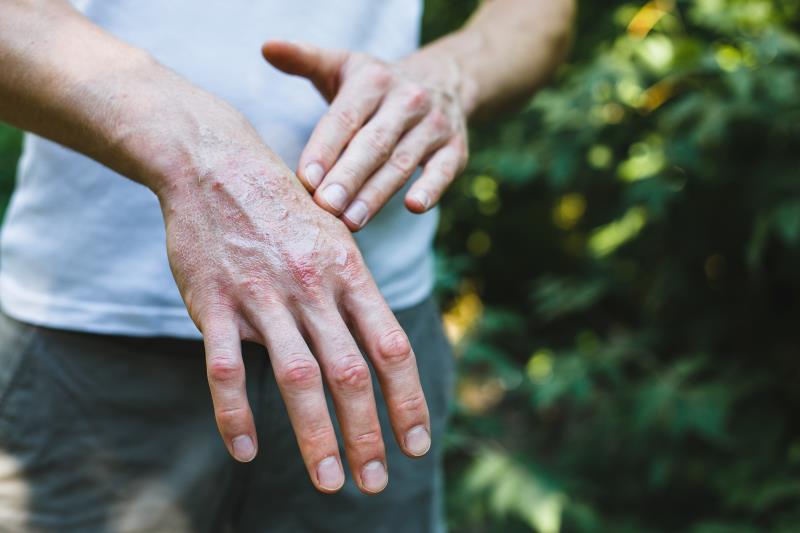Novel IL-17A inhibitor helps dial down psoriatic arthritis disease activity





Potent and selective inhibition of IL-17A by izokibep produced a rapid improvement in disease activity across multiple psoriatic arthritis (PsA) domains, according to preliminary data from a phase IIb/III trial.
Following 16 weeks of treatment, the primary endpoint of 50-percent reduction in symptoms according to American College of Rheumatology criteria (ACR50) was met by a higher proportion of patients who received izokibep 160 mg weekly or every other week vs those who received placebo (40 percent and 43 percent vs 15 percent; p<0.0001 for both), with responses achieved as early as week 4, reported Dr Philip Mease from Providence Swedish Medical Center, Rheumatology Research in Seattle, US. [EULAR 2024, abstract LBA0005]
Responses for other high-hurdle endpoints were also significantly better with izokibep than with placebo, Mease added. Around one in four patients treated with izokibep achieved ACR70 response (25 percent with weekly dosing and 23 percent with every-other-week dosing vs 5 percent with placebo; p<0.0001 for both). Roughly half of patients achieved complete skin clearance on the Psoriasis Area and Severity Index (PASI100) with izokibep (51 percent with weekly dosing and 47 percent with every-other-week dosing vs 12 percent with placebo; p<0.0001 for both), and more than half achieved clear to almost clear skin (PASI90; 64 percent and 58 percent vs 12 percent, respectively; p<0.0001 for both).
Meanwhile, 41 percent of patients in the weekly-dosing izokibep group and 42 percent of those in the every-other-week dosing group had minimal disease activity (MDA) vs 14 percent of those in the placebo group (p<0.0001 for both). MDA, according to Mease, constitutes targets for seven PsA aspects: swollen joint count, tender joint count, PASI or body surface area, patient-reported pain and global disease activity, HAQ-DI* values, and tender entheseal points. Patients who achieved five of these targets were considered in a state of MDA, he added.
Finally, complete resolution of enthesitis occurred in 45 percent of patients in the weekly-dosing izokibep group, 56 percent of those in the every-other-week dosing group, and 47 percent of those in the placebo group. This endpoint was assessed using the Leeds Enthesitis Index (LEI), which relied on a patient’s reaction to pressure applied to specific areas around their joints.
Because of the fairly high placebo response, Mease and colleagues conducted a post hoc analysis that included patients with higher baseline enthesitis score LEI scores 3–6 and 5–6. Results showed more difference between the treatment groups, especially among patients with LEI 5–6 at baseline. For this subset of patients, complete enthesitis resolution occurred in 22 percent of patients in the weekly-dosing izokibep group, 50 percent of those in the every-other-week dosing group, and 12 percent of those in the placebo group.
Well tolerated
With regard to safety, “izokibep treatment was well tolerated, with a safety profile generally consistent with that of other IL-17A inhibitors,” Mease noted.
Most patients had injection-site reactions (61 percent in the weekly group and 46 percent in the every-other-week group vs 5 percent in the placebo group), which were mild to moderate in severity and infrequently led to treatment discontinuation, according to Mease. There were two cases of candidiasis reported, one in the weekly-dosing izokibep group and another in the placebo group. Two cases of ulcerative colitis also occurred, with one in each izokibep dose group.
“Izokibep is a small protein therapeutic designed to selectively inhibit IL-17A with high potency through tight binding affinity. It contains an albumin-binding domain that extends plasma half-life and may enhance targeting to sites of inflammation,” Mease said.
Already, the investigational drug has demonstrated efficacy across multiple PsA measures through week 46 in a prior phase II study, he added. [Arthritis Rheumatol 2023;75(suppl 9):1688]
“Izokibep is a promising new therapeutic, [and the findings of the current study highlight the drug’s potential] to offer deep clinical efficacy across multiple PsA domains, including musculoskeletal, skin, and patient-reported outcomes,” according to Mease, adding that he and his team plan to further explore the drug’s efficacy in PsA through a phase III longer-term extension study.
A total of 343 patients (mean age 51 years, 53 percent male, mean BMI 30 kg/m2, time since diagnosis 7 years) with adult-onset, active PsA (duration ≥6 months and ≥3 tender/swollen joints) were included in the phase IIb/III analysis. All of them had an inadequate response, intolerance, or contraindication to an NSAID, conventional synthetic DMARD, and/or TNF inhibitor.
The patients were randomly assigned to receive treatment with izokibep 160 mg weekly (n=112) or every other week (n=113) or placebo weekly (n=118). Baseline disease characteristics were generally balanced across groups. While the study continued for a full year (52 weeks), the preliminary analysis for presentation focused on the first 16 weeks of data. Mease pointed out that a fourth group receiving an 80-mg dose of izokibep every 4 weeks only had eight patients due to late recruitment and was thus excluded in the analysis.
*Health Assessment Questionnaire—Disability Index